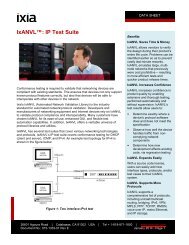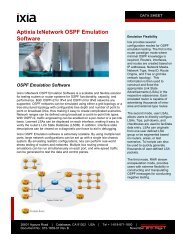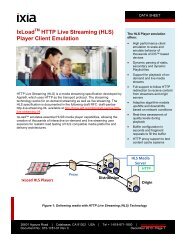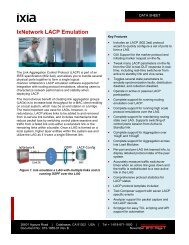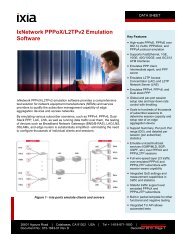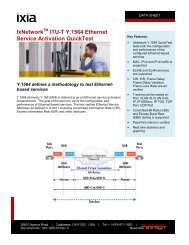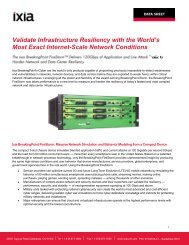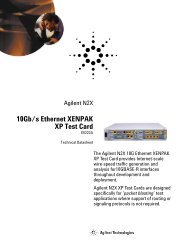Testing PPPoX and L2TP Broadband Access Devices - Ixia
Testing PPPoX and L2TP Broadband Access Devices - Ixia
Testing PPPoX and L2TP Broadband Access Devices - Ixia
You also want an ePaper? Increase the reach of your titles
YUMPU automatically turns print PDFs into web optimized ePapers that Google loves.
Overview<br />
Modern broadb<strong>and</strong> networks deployed to provision xDSL<br />
or cable-based high-speed Internet access services to<br />
residential <strong>and</strong> commercial users rely on a number of<br />
complex devices to offer a high quality experience to the<br />
user. Prior to network deployment, these devices are<br />
commonly tested for:<br />
• Performance, e.g. can the device h<strong>and</strong>le a specified<br />
number of session setup requests per second<br />
• Scalability, e.g. does the device meet its maximum<br />
session specifications<br />
• Functionality, e.g. do the advanced firmware features in<br />
the device interoperate with other parts of the network<br />
while maintaining scalability<br />
This document provides test case examples covering these<br />
requirements for three main device classes, namely:<br />
• Broadb<strong>and</strong> Remote <strong>Access</strong> Servers (BRAS)<br />
• Layer 2 <strong>Access</strong> Servers<br />
• Layer 2 Network Servers<br />
Four iterative test case examples are being presented.<br />
• <strong>PPPoX</strong> client performance <strong>and</strong> scalability test<br />
• <strong>PPPoX</strong> client <strong>and</strong> server performance <strong>and</strong> scalability test<br />
• <strong>L2TP</strong> LAC performance <strong>and</strong> scalability tests with<br />
<strong>PPPoX</strong> traffic<br />
• <strong>L2TP</strong> LNS performance <strong>and</strong><br />
scalability tests<br />
<strong>PPPoX</strong> includes a number of<br />
technologies such as PPPoE,<br />
PPPoA, PPPoEoA, PPPoEoVLAN.<br />
The <strong>PPPoX</strong> version tested depends<br />
on the interface options available in<br />
the Device under Test (DUT)/<br />
System under Test (SUT) <strong>and</strong> the<br />
corresponding <strong>Ixia</strong> Load Module.<br />
While the total number of <strong>PPPoX</strong><br />
sessions needed to perform stress<br />
tests depends on capabilities of the<br />
DUT, this document assumes that<br />
the test tool is capable of generating<br />
32,000 sessions per test.<br />
1. <strong>PPPoX</strong> Client Performance<br />
<strong>and</strong> Scalability Test<br />
1.1 Objective<br />
The objective of this test is to characterize the performance<br />
of both LAC <strong>and</strong> LNS/B-RAS devices while simulating<br />
32,000 <strong>PPPoX</strong> sessions. The test is split into three phases,<br />
namely:<br />
• Baseline session setup <strong>and</strong> teardown tests.<br />
• Simulating access link failure test. This can be achieved<br />
by simply disconnecting <strong>and</strong> reconnecting the link<br />
from the test tool to the DUT to observer service<br />
recovery times.<br />
• Simulate DUT failure test. This can be achieved by<br />
re-booting the DUT.<br />
1.2 Setup<br />
The DUT may consist of single or multiple devices (i.e.<br />
<strong>Access</strong> concentrator/LAC <strong>and</strong> LNS or LNS or BRAS, etc.).<br />
As shown in Figure 1, an <strong>Ixia</strong> GigE Load Module port<br />
(copper or fiber) or ATM Load Module port (OC3 or<br />
OC12) may be used to generate the required number<br />
of subscribers (access users) for one or more <strong>PPPoX</strong><br />
sessions.<br />
Figure 1: <strong>PPPoX</strong> client emulation setup<br />
PoE Test Plan Copyright © <strong>Ixia</strong>, 2004 1



